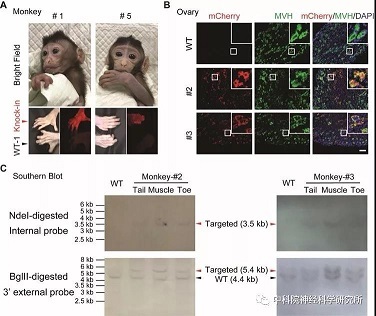Guide
The Yang Hui Research Group of the Institute of Neuroscience, Chinese Academy of Sciences, Center for Excellence in Brain Science and Intelligent Technology, and State Key Laboratory of Neuroscience, and Sun Qiang, a team of Suzhou non-human primate research platforms, used a terminal mediated by a homology arm. The conjugated (HMEJ)-based gene knock-in strategy, for the first time in the world, has obtained gene knock-in cynomolgus monkeys.

On January 12th, this important research was published online in the journal Cell Research under the title "Getting Crazy Monkeys by Using CRISPR/Cas9 Editing Techniques".
Since the genetically modified monkey model can be used to mimic the symptoms of human disease, it can be used as a tool to study the mechanisms of human disease and advance clinical treatment. However, due to the long reproductive cycle (5-6 years), the small number of pups (one per fetus) and the low efficiency of gene editing, it is very difficult and challenging to construct a targeted gene editing monkey. . Recent studies have shown that the CRISPR/Cas9 system can be used to construct knockout monkeys. However, contrary to gene knockout, for various reasons such as low efficiency, there have been no reports of successful knocking of monkeys into monkeys so far.
Based on previous laboratory studies, homology-arm-mediated terminal ligation (HMEJ) methods can efficiently achieve efficient targeted gene integration on macaque embryos. The researchers further optimized fertilized egg injection conditions, including donor plasmid concentration and injected dose, and hope to improve normal knocking efficiency while maintaining normal embryonic development, thereby obtaining gene knock-in monkeys. Specifically, the researchers inserted p2A-mCherry at the Actb (β-actin) site to allow expression of mCherry under the control of the Actb promoter. After a full pregnancy cycle, the researchers successfully obtained a pair of twin monkeys (#1, male; #2, female) and three single female females (#3, #4, and #5). The toe of two newborn monkeys (#1, #5) was observed by direct epidermal fluorescence, and #1 and #5 exhibited mCherry fluorescence compared to the wild type. The tissues of the two dead female monkeys (#2, #3) were sectioned and found to have different chimeric degrees of mCherry expression in the tail, toe, heart, muscle, heart, kidney, brain and ovary. It is worth noting that the researchers detected mCherry expression in most areas of the ovary, indicating that the knock-in monkey has the possibility of germline transmission. PCR identification sequencing results for all tissues indicated that integration at the 5' and 3' junctions was correct. In addition, Southern blot analysis further confirmed that the gene integration of #2 and #3 monkeys was correct and there was no additional random integration of genes.

"Researchers used the CRISPR/Cas9-mediated HMEJ strategy to successfully acquire gene-targeted integrated cynomolgus monkeys for the first time through a single cell embryo injection." Experts say that based on its powerful DNA knock-in efficiency and high fidelity, HMEJ The guided knock-in strategy offers the possibility to construct a monkey model that targets genetic modification.
According to reports, this work was completed by assistant researcher Yao Wei, postdoctoral Liu Zhen and graduate student Wang Xing under the guidance of Dr. Yang Hui, a researcher in the primate disease model research group and Dr. Sun Qiang, director of the Suzhou Non-Peopletic Research Platform. It has also received major national science and technology projects, the Strategic Science and Technology Special Project of the Chinese Academy of Sciences, the National Natural Science Foundation of the National High-Tech R&D Project, the China Youth Thousand Talents Program, the Chinese Academy of Sciences Major Breakthrough Project, the National Key Technology R&D Project, and the Shanghai Science and Technology Commission Project. Funding for projects such as the 100-member program of the Chinese Academy of Sciences.
Shanghai Chuangsai Technology has excellent performance, interleukin cytokines, fetal bovine serum, electrophoresis equipment scientific instruments, raw material drug standards, chemical reagents, cell culture consumables, Shanghai Chuangsai, mass products special promotions, welcome to inquire!
Henan WonkingChina I/E Co., Ltd. , https://www.wshousewares.com